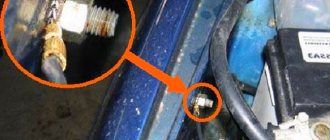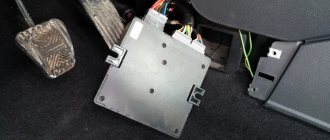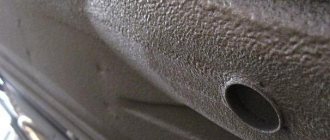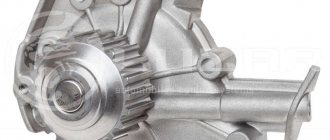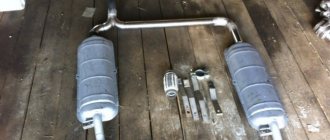Every year the amount of electrical equipment on a car increases. And although, thanks to the miniaturization of electronic components, it is still possible to keep this entire mass on a 12-volt on-board network, the situation in the medium term may become critical. But even today, a lot depends on the wiring and, of course, on the quality of the mass, which has a direct impact on the accuracy of the functioning of sensors, sensors, controllers and other components of electrical equipment.
The electrical mass, as is known, is part of the on-board electrical network, connecting the battery and the vehicle body, the latter being a conditional return segment forming a closed autonomous system.
This means that the car body acts as a conductor of electrons with a negative charge. But the capabilities of the standard mass do not always satisfy the increased load on the network. That is why they de-minus the engine, connecting the most powerful consumers to additional mass.
What is engine demining?
Structurally, the car has a developed electrical system, in which the serviceability and accuracy of the controllers, various sensors and many other electrical devices depend on the mass. The electrical ground (minus) is connected from the battery to the car body. The body is conventionally a return wire, forming a closed electrical circuit.
The movement of electrons along the circuit is initiated by the battery, and the body acts as a conductor of negative charge for return via the negative terminal. For this reason, the metal body of a car is called car body. In this case, engine demining should be understood as a number of improvements that involve additional connection of the most powerful consumers of electricity in the car to ground.
Problems with bulk wires
How do problems with ground contacts manifest themselves?
Engine
If the ground wire from the ECM is oxidized or disconnected, this manifests itself in a spontaneous change in operating modes or the car suddenly stalls. Poor contact from the torpedo causes unstable engine operation at idle.
If the contact is broken, the battery charge deteriorates, the starter speed decreases during startup, problems arise in the ECM, because the second ground wire from the battery goes there. To correct the violation, first check the tension of the nuts securing the thick wire to the engine.
To do this, the outer nut is loosened, the inner nut is checked and, if necessary, tightened. The outer nut is then screwed back on. The thin wire is the main conductor of the negative charge. In case of malfunctions, check its condition and the tightness of the nut on the housing, as well as the bolt on the battery terminal.
If you find a point with poor contact, completely disassemble the assembly, find all burnt and oxidized areas, clean and level all surfaces before reassembling. Crimp and solder all terminals.
Problems may arise due to the lack of a castle washer under the bar and a loose nut connecting the stud and wire in the factory configuration. Over time, due to the resulting backlash between the pin and the wire, voltage surges appear in the channels of several sensors. The result is an uncontrolled increase in engine speed when the fan is turned on.
Why do they do the de-mining?
During the operation of the car, you may encounter the fact that the electrical on-board network literally “sags,” especially at times of peak loads (simultaneous activation of the dimensions, low and high beam headlights, various heated mirrors and windows in parallel with the use of the air conditioning system, electric windows, powerful acoustics and other devices).
Also, voltage dips can occur for no apparent reason, affecting the stability of the internal combustion engine, its ignition system, ECU, sensors, servos and other electrical devices. This can happen if oxidation has occurred in the place where the negative terminal is normally attached to the body, the contact has broken down, or corrosion has appeared. The automobile electrical network naturally begins to operate unstably.
In the first case, additional demining of the engine is often necessary due to the fact that the car body is old, the standard place for attaching the mass has become unusable, etc. Regarding improvements and tuning, there is an opinion that additional de-mining allows a more even distribution of electricity in the vehicle’s on-board network compared to using the standard negative terminal.
Additional ground wires
An additional ground wire from the dashboard can be routed from the cigarette lighter ground to the inner metal base of the center console of the dashboard. As a rule, the additional weight of the VAZ 2114 from the torpedo is installed if the car has a standard dashboard. The cross-section of the additional wire must be at least the same as that of the standard wire.
You can check which panel you have by looking at the mounting of the ECM controller - with a plastic adapter between the controller and the metal base, and the presence of a diagnostic connector in the standard place under the ashtray (behind the decorative plug). If both signs are present, you have a standard panel.
Additional wires are often installed on cars with high mileage. Such cars often have ground problems, and instead of searching, owners install new wires, for example, on the alternator with the battery, or on the metal part of the center console with the battery, to prevent battery charge from leaking.
Knowledge of where the ground is located on the VAZ 2114, what signs indicate poor contact with the ground and the ability to troubleshoot problems will always be useful in order to prevent serious damage to the electronics and engine of the car in time.
Serena. Electrics. Club of fans of minibuses and minivans
- Unanswered topics
- Active topics
- SearchMobile version
Additional Weight: Benefits
Engine demining for the purpose of improvement has both supporters and opponents of this method. Skeptics consider this solution a waste of time and money, citing the fact that standard solutions in the car are quite sufficient, the cross-section of the factory wires is sufficient, each sensor has its own separate negative ground (sensor ground), etc.
The main argument among those who have already implemented the procedure is the stability of spark formation and operation of the entire ignition system as a result of the most efficient and reliable mass in the car. It is also claimed that the mass becomes even for all devices that consume electricity. Such uniform distribution cannot be achieved with standard mass, even if the terminals are cleaned regularly. The list of main advantages of power engine demining includes:
This modification makes it easier to start the car and increases the stability of speed in idle mode (the speed does not fluctuate). It was also noted that after the diesel or gasoline engine has been de-energized, headlights begin to shine brighter, increasing the comfort and safety of movement at night. Additionally, it is worth noting that after de-mining, interference and interference are minimized or completely eliminated, and music from the media and radio in the car’s speaker system begins to play clearer. Another advantage is increased safety for electrical equipment in the event that the standard ground wire breaks or its attachment to the body is destroyed.
Increase in working volume
It is this indicator that small car owners are embarrassed to cite when they are asked about the car’s characteristics. Well, increasing the volume of the combustion chamber is perhaps the most radical way to make your car more responsive and dynamic.
It is known that the concept of “engine displacement” includes several interrelated characteristics: how much the piston moves, what is the number and diameter of the cylinders. But since it is structurally impossible to change the number of cylinders even theoretically, the impact on the other two above-mentioned parameters remains.
Increasing the diameter of the cylinders is, in principle, possible, but since they move in chambers designed specifically for factory dimensions, boring the cylinder block to the appropriate size will be required. If the BC is made of cast iron, new larger pistons must undergo additional processing, which consists of applying microroughness to the piston walls, which serves to retain the oil film. Needless to say, it is almost impossible to carry out such work in a garage environment.
If the cylinder block is made of aluminum and equipped with wet insert liners, the task is much simpler. In this case, boring is not required - just replace the liners with products of the required diameter, purchasing them at any auto store.
The second way to achieve the required results is to change the piston stroke upward. Structurally, this can be done by using a crankshaft with a different geometry (the crank radius increased by a certain amount). Choosing a suitable crankshaft will not cause problems either - there are a considerable number of products on sale designed for installation on different types and modifications of power units, including forced ones.
Of course, the increase in engine power when using such a radical method will be quite noticeable. But do not forget that this characteristic of the car is closely related to other parameters (in particular, torque and crankshaft speed). In fact, an increase in piston stroke means that the greatest amount of torque is developed at a minimum value of crankshaft rotation speed.
If we talk about specific numbers, an increase in the piston stroke/cylinder diameter provides an increase in power of about 10%, while engine operation in all modes will become noticeably smoother.
Among the disadvantages of this method, it is worth noting the following:
- increased fuel consumption (by about the same percentage);
- the high cost of the procedure itself;
- in some cases, it becomes necessary to change the design of the clutch; for correct operation of the ECU, a corresponding flashing will be required;
- in such cases, the use of low-quality oil and fuel is extremely undesirable;
- The engine life will decrease due to a decrease in the thickness of the cylinder walls.
How to de-minus the engine yourself
The procedure involves running additional wires to ground from the main sources of current consumption.
For most cars, the minus is carried out from 4-6 sources: It is worth adding that you can purchase both ready-made solutions on sale and do the engine demining yourself. For manufacturing you will need a copper cable, heat shrink tubing and terminals. The length of the cable and the number of terminals will depend on how many devices are planned to be grounded to the body (connected to ground). After cutting the cable, you need to crimp the terminals and apply heat shrink in those places where the cable is exposed to connect to the terminal. The final stage will be the installation of the manufactured wires in the engine compartment of the car.
How does the engine start button work? Available options and solutions for installing the starter button yourself. How to install the engine start button yourself.
Signs of malfunction or breakdown of the high-voltage spark plug wire of the ignition system. How to check car armored wires with your own hands.
The starter clicks and/or buzzes, but the engine does not turn over. The main causes of starter failures, diagnosing and troubleshooting them yourself.
How to quickly start the engine with a discharged battery. Features and advantages of using an autonomous battery charger. Tips for choosing a booster.
Conditions for proper storage of a car battery. Removing, inspecting and preparing the battery. How to preserve your battery without regular recharging.
Basic methods for repairing a cracked engine block. Crack detection, repair by welding, riveting or applying an epoxy layer.
Source
Electrical ground diagnostics
The following sections are divided between tests. This will make it easier to test the starter and accessory ground paths to identify common electrical system problems.
We recommend reading: Water in the car after rain
Here are some important points to keep in mind when troubleshooting your car:
- When testing, make sure the terminals are attached to an unpainted surface. You have to connect to bare metal. Paint, corrosion, greasy surfaces, frayed or broken wires, and loose connections are the main causes of poor automotive finishes.
- Some vehicles use a separate chassis ground wire in addition to the main one (black battery cable) that runs from the negative battery terminal to the chassis. This is for headlights, accessories and other electronic equipment.
You can use the remote starter switch to crank the engine while testing your vehicle. Connect the switch to the battery and the "s" terminal on the starter solenoid or remote starter relay.
Where is the ECU ground located?
The ECU mass is usually arranged like this. Separate ground wires are removed from the ECU connector and connected to the engine via the starter mounting bolt. Ground wires are usually black.
In the photo, the thick wire is from the battery, and the thin wires are from the ECU and speed sensor
Everything is simple and reliable. But in reality, over time, the voltage begins to drop in this section of the circuit, slowly but surely, disrupting the operation of the system.
Therefore, this unit must be periodically checked and maintained. We will look at how to do this further.
parking lights
For example, the electrical circuit of a Lada Priora station wagon has the function of both automatic and manual activation of side lights. The activation itself occurs after turning the handle for the side lights and headlights on the dashboard. The contact is triggered and the lights turn on.
The circuit contains fuses that serve to protect against overvoltages and short circuits. Power is supplied to a lamp located on the dashboard. To adjust the brightness of the lights, a special regulator located on the lighting control module is used.
The headlight design of the Priora differs from other cars. The electrical circuit of the VAZ Priora contains a light sensor, as well as a lighting control unit. After turning on the ignition and the lighting control button, the electronic unit responsible for lighting control is activated.
If there is not enough light outside, the unit receives a signal from a sensor located on the windshield. There is also a rain sensor there. After receiving such a signal, the electronic control unit supplies power to the electromagnetic relay coil. Power is supplied to the headlights.
Weight between engine and body
Line “31”, popularly called “ground”, “minus” or “negative circuit”, is very important for a car. And not only for electrical equipment, but also for many other systems, including the engine or automatic transmission.
Almost all cars have a single-wire on-board network system and the role of the “minus” in this circuit is played by the metal parts of the body. This greatly reduces the number of wires and reduces the cost of the car.
It turns out that all participants in this chain have their own connection to the body - instrument panel, headlights, ECU, engine, etc.
Despite the visual integrity of these connections, over time, due to oxidation and corrosion, the contact slowly and imperceptibly deteriorates, which leads to voltage drops when powerful consumers are turned on or disruption of the system.
I would divide the mass connections into main and local. Let's say that the connection of the head light masses is local and if this connection is disrupted, only the head light will suffer. But if the ground contact from the battery to the body is broken, the entire on-board network will suffer, and this may cause problems in the operation of the engine and other important components and assemblies.
This is how the voltage of the on-board network with problematic masses looks like on the diagnostic graphs
And here is the graph after mass prevention of battery - engine - body
Therefore, a reliable engine-body mass is very important for the proper and trouble-free operation of the entire vehicle.
In general, the ground chain must be maintained in perfect condition. It's like an axiom.
Next, let's look at where the engine-body mass is located and how to check it.
Lada 4×4 3D: ❋ Mazyunya ❋ › Logbook › Why are we worse than the Japs?! [DIY backing track]
So, having quit my former job (which was terrible, by the way), I thought that I would work on the car every day, that I would make candy out of it and everything would be fine with me =) Guys, life really sucks)))) Actually, of course , I now have more time for my personal affairs, but I also have more troubles, because... I am now responsible for raising (as well as feeding, walking, entertaining, washing, partly cooking and a bunch of other household chores) of my offspring.
But despite all my housework, I still devote time to my car. I have long wanted to bother with improving the weight of the car (not the same weight as in gravity, of course), namely, spreading the good minus over the body and the main current-consuming units. For what is all this needed? It’s just that most of the electronics problems in our cars are associated precisely with poor grounding, when the bolts rust, the contact disappears or simply becomes floating. In a word - it's an ass, seriously. That's why I got confused with the minus to begin with. According to reviews from the owners of such a gadget, the car is simply unrecognizable after installation - it runs smoother, eats less, drives faster, lights better, and in general Agent007 himself would envy such a car with a similar device. It’s not for nothing that the Japanese have dispersed the mass from the factory.
Of course, I didn’t believe in this whole wunderwaffle, but I found it useful. I asked my dad at work to give me 5 meters (for sure))))) of copper braid and a copper die for wiring the terminals.
I drove to the nearest electrical goods store and bought 6 (for every fireman) JG-10 copper, tinned, terminals for crimping. Next, I estimated the approximate length of our wires and cut the braids. We clean one of the ends of the resulting wire, twist it and carefully tin it. We push it into our terminal, press it with pliers (but it’s more convenient with wire cutters, the main thing is not to overdo it), fill the terminal cavity with tin and squeeze it again while it’s hot. Then, to make it kosher, you can tin it together with the terminal.
Where is the mass of the engine - battery - body
On most cars, the engine-body mass has a primitive appearance and is made of two pieces of cable connected together by crimping on the negative terminal of the battery
This crimp connects two wires. One goes to the engine and is secured with the starter mounting nut...
...and the second one on the body in the area of the left wing
It would seem that this is the simplest and most reliable chain that will serve well for years. But this is not at all true and it’s all to blame for the weak points in this design, which do not withstand the test of atmospheric influences.
How to check mass on a car
In fact, only a small group of motorists pay enough attention to this issue. Others begin to think about it when, when the cooling fan or headlights are turned on, the engine speed begins to sag, or when the rear window heating is turned on, the engine begins to tremble, transmitting vibration throughout the body.
But even at this stage, many limit themselves to a banal inspection and tightening the ground connection nuts on the engine and body. Everything is screwed down - that means everything is in order.
Then the car begins to jerk for no apparent reason, idle speed freezes, misfires, security system glitches, and so on, until the starter fails at the most inopportune moment. But even here, many will not go check the masses, but will run to the store for a new starter. After all, the wire to the starter is intact and there is voltage, but it, a radish, does not turn.
Replacing the starter, of course, does not help. As a result, the still-living battery goes into recycling and the situation seems to have improved, but after a couple of days the starter fails again and you begin to believe in brownies and otherworldly forces that have nothing better to do than cause damage to someone else’s car.
How to check mass with a multimeter
Disconnect the negative terminal of the battery
We take a multimeter and switch it to resistance measurement mode up to 200 Ohms. We check the resistance of the probes themselves by connecting them together
The resistance of the probes themselves is 2.1 Ohms.
Now we connect one probe to the engine. At least here
And the second probe is to the engine control unit, which, in turn, is screwed to the body
What happens - the mass resistance of the engine - the body has practically no resistance? Is everything perfect? Is the engine and body weight OK? What is the problem then? Is the starter defective or are otherworldly forces overcoming you?
The whole thing is much simpler. What is a mass chain in the understanding of an ordinary person? This is just a piece of wire that connects the engine to the body. Just a piece of wire! If we connect ohmmeter probes to the ends of this wire, then we will find out its resistance. It will be minimal - it’s just a piece of copper wire. Right? Right.
If we connect the voltmeter probes to the ends of this wire, we will see zero voltage. After all, where will the potential difference come from on a single piece of wire? Right? Right.
Now let's connect our voltmeter to this ground wire on the car. That is, as when measuring resistance, one probe is to the engine, and the second to the body. They are connected by this piece of wire. Right? Right.
We switch the multimeter to the mode for measuring constant voltage up to 2 Volts. We start the engine and look at the device display.
Oops. And we have tension!
How can this be - we are connected to the ends of one wire, and we have voltage.
So I showed off my artistic creativity and painted a picture of what was happening
Red is the ground wire, and blue is the voltmeter.
These values on the multimeter display are nothing more than the voltage drop on our ground wire! Even though it looks great and has minimal resistance, it still drops voltage. Moreover, the greater the consumer current in the circuit, the greater the voltage drop on this wire will be, which can reach several volts!
This is the situation. And the mass of the engine and body is not as good as it seemed at first, and problems from it are inevitable.
How to come out of such a situation as a winner?
First, it is necessary to periodically service this section of the chain.
Unscrew the mass on the body
Do the same with the mass on the engine.
But this doesn't always help. The fact is that this chain still has weak points - crimps.
Crimping lugs, crimping on battery terminal
All this oxidizes over time and cannot fully perform its function.
It is necessary to either re-crimp these connections, or it is better to change these wires sometimes.
Here is a video on the topic engine mass - body
Well, ideally, you can run additional ground wires: Generator - body
Source
Checking weight in a car
Transmissions on some vehicle models are equipped with a chassis or protective shield for modules, sensors, and solenoids (relays). You can also test these grounds using your digital multimeter.
- Check the voltage drop between the transmission and the negative terminal of the battery. The voltage drop should be 0.2V or lower.
- Check individual chassis grounding by checking the voltage drop across each ground terminal on the transmission. The voltage drop should be 0.2V or lower.
Clean, repair or replace the transmission ground as necessary. Remove grease, rust and paint from ground terminals or replace damaged ground straps.
General Voltage Drop Values
Choke cables and other equipment can be damaged when high electrical current cannot find the correct path back to ground.
